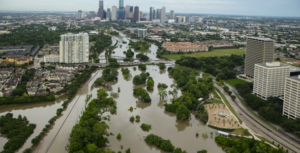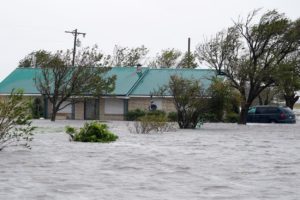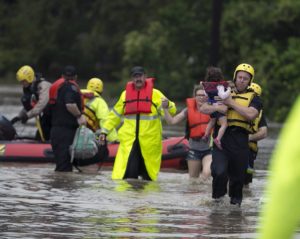
As I write. Houston has had 50 inches of rain with more to come, water is overflowing from the Addicks Reservoir and tens of thousands have been displaced by flooding. Hurricane Harvey while the worst in recorded history, is a harbinger of natural disasters to come. Polar ice is melting at an unprecedented rate and glaciers are disappearing, both inland and on the coasts. South Sea islands are shrinking from rising seas to the point that some populations have started relocating to other places. Extra water in the sea and higher temperatures increase the number and severity of hurricanes.
So how do you prep for natural disasters? I hear stories of families trapped in second floors or roofs in Houston with no food or water. Evacuation would have caused conditions similar to the conditions of Hurricane Isaac where cars were stranded in a 100 mile traffic jam that would have been soon under water. Geographically the area is flat and no one could predict the safest place to go and roads were not elevated. People tend to like to live in dangerous areas- on cliffs, by seashores, on islands, near creeks. They also prefer not to pay for infrastructure that might protect them.
My cousin lives in Houston and he selected a home on relatively high land in a 1,000- year flood zone (100-year flood zones are regularly flooded these days.) It is located 2-hours inland. The subdivision was designed with below-grade streets that can shunt water away from homes. The roof Is strong (although if predicted tornados come there is no assured safety.) He and his wife were able to safely shelter in place during the hurricane.
My husband’s parents lived in a hilltop town in Italy, surrounded by a medieval wall, where everything is in walking distance. Water was collected in cisterns on the roof, even when running (which was not 25/7). Aside from kitchen vegetable gardens, farmland was outside the wall in lowlands where good moisture was possible. This was a defensible location.
I worked in Ft. Myers, Florida as a county planner in an area where sheet flow from the Caloosahatchee River flooded each summer. Northerners would purchase mobile homes during the dry season without looking at the one-foot topographic maps. (The highest point in the county was 25 feet and there was a huge sinkhole in Lehigh Acres.) They often lost their homes in the next year or two.
So there are many things you can do to protect yourself:
1. Choose a geographical location that is relatively safe. Coastal cities, low land, hurricane zones, earthquake faults, areas subject to landslides, and large wooded areas with trees around homes in fire-maintained ecosystems should be avoided. Forests with significant insect infestation or dead tree litter may be subject to megafires.
2. Find the safest location within the area of choice: a hill is usually better than flat land, unless prone to landslides or volcanic activity. Check out flood plain maps (1000 year best), earthquake fault line maps, sinkholes, superfund sites, nearby noxious uses.

REUTERS/Rick Wilking
3. Look for good infrastructure: good sewers, structural roads that don’t back up with water, permeable paving requirements, sewerage, underground power lines in watertight tunnels, flood caps on subway entrances, elevated roads over flood-prone wetlands, enough culverts along otherwise water-blocking roadways. Ask potential neighbors about conditions.
4. Look for the weak areas and choose defenses accordingly. If tornados are a problem then have a good underground shelter/root cellar. If landslides are a problem, plant shrubs and trees with a good root system. If flooding is a problem, look for berms around the house, elevated construction with upstairs living quarters, local drainage. Pass on the house on the earthquake fault line. Also pass on the highrise condo with ground floor or basement elevator rooms and water pumps, stairwells without windows or skylights. During superstorm Sandy, older people were trapped on upper floors with no running water or electricity and they could not go down 20 stories in the dark.
5. Have enough first aid supplies, water and food, candles and matches, pet food, incontinence supplies, prescription meds and somewhere to defecate (say a bucket with kitty litter) and other essentials including paperwork (passport, SS cards, mortgage documents, insurance papers.) The latter should be stored in a watertight case.
Do not store the supplies in the basement or garage if you are prone to flooding- store it upstairs. Perhaps store it in the root cellar in tornado country. Have some of your provisions hidden and store in divided locations. The amount you need should keep depends on the amount of time you think will be necessary to recover, but in no case less than 72 hours per person.
6. Consider an upstairs roof deck and stairs to the attic if children and the elderly are present in flood country. On lowlands in flood zones make sure you have a way out of the attic. Avoid sheetrock which can become moldy on lower floors
7. A source of solar or wind energy is desirable, especially where help may be long in coming. More efficient forms are becoming available, so if you were told that you lacked enough sun or wind, that may be no longer true. Solar roof tiles are discrete if you need secrecy. Store propane tanks far enough from the house that an explosion from a fire will not burn you down.
8. I have not addressed defense from people. Your best defense is to form strong bonds with your neighbors, possessing a useful skill like first aid, mechanics or woodworking and encouraging them to prep. Making your home look like a fortress advertises that you have supplies others might want. Decorative but functional cast iron on the first floor may secure you from unwanted visitors, but you may morally wish to help others and that may well be what keeps you human. Just make sure you practice safe compassion. There are examples of Houston neighbors using their own boats to save others and sharing food which saved many lives. Don’t develop a bunker mentality until you need to.
9. Take Red Cross or similar courses in first aid, CPR, life guarding, boat safety, HAM radio, and survival skills. Train as an EMT or volun

teer firefighter. In forest fire country, consider hotshot training. Outside of San Antonio, Sam Coffman and Suchil Coffman-Guerra run The Human Path which teaches survival skills, herbal medicine for professionals and similar classes. Tom Brown Jr. teaches tracking and skills in living off the land in his wilderness school. Ricardo Sierra and Trista Haggerty run Earth Mentoring Institute, Inc/Hawk Circle Wilderness Education in Cherry Valley, New York. NOLS teaches wilderness medicine all over the world. I teach herbal medicine in Brooklyn and am on the board of two nonprofit acupuncture groups that serve in emergencies (CRREW) or for underserved populations (Global Clinic.) If you have skills, start a group of your own or join one.

